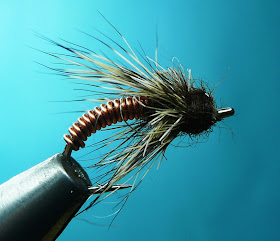On a friend's request, I have been tying some brassies in recent days with a green tag. It is one of those patterns if somebody asked you for a dozen, you would reply, 'are you sure now, is that all? It is of course, a simple wee pattern with the reputtation of being a deadly fish catcher as well - the fly tyer's dream really! This green tag brassie has been successful for my friend when fished as part of a team of nymphs from the boat. I'll send these off tomorrow. I must admit - I have never fished much with a brassie or caught anything with it. Yes, US readers, you read corectly! But I'll keep a few aside to have in the box and see if can I break my 'brassie duck' someday. Anyway, I could not resist tying some variants. As evident in some cases, I treat the term 'variant' very liberally. Indeed, I have maybe went 'off steer' slightly, ah well!
According to Dave Hughes in 'Trout Flies - The Tier's reference' (1996), the brassie was orginally tied to imitate small caddis larvae that live in fast water. Yet, it is also now used for a range of imitations - midge larvae and pupae, and even mayfly and stonefly nymphs. It was devised by Ken Chandler and Tug Davenport on Colorado's South Platte River in the 1960s. It has been suggested that the original brassie had short piece of black heat shrinked plastic tube for the thorax and black tying thread as the body. As a footnote point, you will commonly see brassies tied with a peacock herl thorax, or with a bead-head.
Dark Brassie
Hook: Kamasan B100
Body: Black and Cooper Wire wound together
Thorax: Squirrel underfur mixed with small amount of cooper litebrite
Rick Murphy - also of the South Platte River came up with the idea of using two colours to give a segemented body in his two wire brassie (Greenhalgh and Smalley, 2009). This creates some lovely effects and colours. Similar to above, here are a few buzzer patterns using two colours of wire for the body:
Dark Green buzzer
Hook: Kamasan B110
Tail: White organza
Body: green and black wire wounded together
Thorax: Black lite brtite mixed with muskrat
Breathers: White organza
Brassie (Original)
Hook: Kamasan B420
Body: copper wire
According to Dave Hughes in 'Trout Flies - The Tier's reference' (1996), the brassie was orginally tied to imitate small caddis larvae that live in fast water. Yet, it is also now used for a range of imitations - midge larvae and pupae, and even mayfly and stonefly nymphs. It was devised by Ken Chandler and Tug Davenport on Colorado's South Platte River in the 1960s. It has been suggested that the original brassie had short piece of black heat shrinked plastic tube for the thorax and black tying thread as the body. As a footnote point, you will commonly see brassies tied with a peacock herl thorax, or with a bead-head.
Brassie (Variant)
Kamasan B170
Kamasan B170
Body: copper wire
Rib: Black silk
Thorax: Fine black fur
Green Tag Brassie
Hook: Kamasan B175
Tag: flou green tying silk
body: cooper wire
Thorax: Hare's ear mixed with red fox squirrel
Hairy Fat Brassie
Hook: Kamasan B420
Body: Cooper wire
First thorax: Short length of red squireel underfur
Hackle/wing: Deer hair on a dubbing wire (wound with several turns towards the body and then pushed up).
Thorax: Red squireel underfur dubbed into a tight ball
Dark Brassie
Hook: Kamasan B100
Body: Black and Cooper Wire wound together
Thorax: Squirrel underfur mixed with small amount of cooper litebrite
Rick Murphy - also of the South Platte River came up with the idea of using two colours to give a segemented body in his two wire brassie (Greenhalgh and Smalley, 2009). This creates some lovely effects and colours. Similar to above, here are a few buzzer patterns using two colours of wire for the body:
Dark Green buzzer
Hook: Kamasan B110
Tail: White organza
Body: green and black wire wounded together
Thorax: Black lite brtite mixed with muskrat
Breathers: White organza
Light Green Buzzer
Hook: Kamasan B110
Body: Green and White wire winded together
Thorax: Orange glo-brite floss followed by muskrat fur mixed with pesudo peacock herl
Breathers: CDC white strands
JC Brassie buzzer (black)
Hook: Kamasan B110
Body: Green and White wire winded together
Thorax: Orange glo-brite floss followed by muskrat fur mixed with pesudo peacock herl
Breathers: CDC white strands
JC Brassie buzzer (black)
Hook: Kamasan B100
Tag: flou green
Body: black wire wound loosly over the body
Cheeks: Jungle cock feathers tied on each side
Thorax: black SLF mixed with squirrelBrassed off-soft hackle
Hook: Kamason B110
Body: orange and black wire
Thorax: grey seals fur
Hackle: Black hen









These will keep me busy for a while. Will tie some to fish below an indicator or big dry fly on some of my favourite still waters.
ReplyDeleteThanks Phillip. Im sure you will enjoy tying them and please let us know how you get on with any of the patterns.
ReplyDeleteThe orange-and-black will work nicely now for Halloween.
ReplyDeleteScary tyin', man.